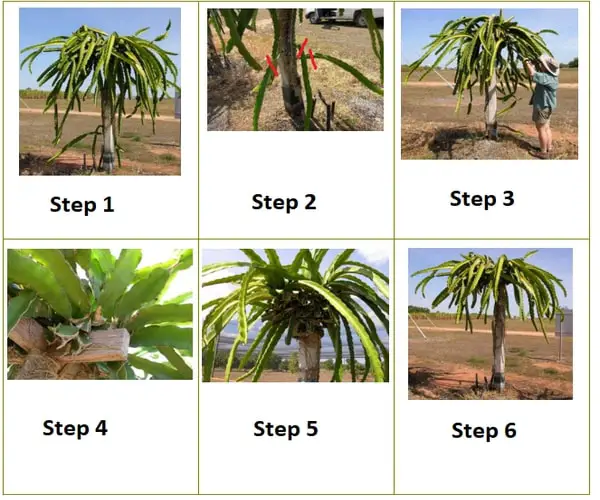How to Prune Dragon Fruit [Easy Guide]
For balanced growth the dragon fruit plant needs pruning .There are two types of interventions necessary to obtain maximum production: training pruning and production pruning. In this article we will show you how to prune dragon fruit step by step.
Dragon fruit is one of the brightest fruits, with an exotic appearance and delicious texture. It is part of the cactus family and also known as pitaya or dragon fruit.
Its leathery shell is bright pink with yellow and green thorns, and the inner fruit has many tiny seeds and a kiwi-like creamy texture. The fruit has a mild, sweet taste very similar to kiwi and pears.
The dragon fruit is a plant that grows very fast, forming a dense mass of stems. For this reason, pruning is an essential task to keep the plantation in good condition.
The most usual multiplication of pitahaya is through vegetative propagation by means of pruning. Propagation by seeds is not advisable, since it is a very slow process, and it can take at least 7 years to be a productive plant.
The pruning must be placed with the same orientation as they were on the mother plant, cutting the apical end to break dormancy and to make shoots more rapid. The risks must be periodic, as well as the elimination of weeds. Under these conditions, the plant material must remain for about 3-4 months before the final transplant.
| Methods How to Prune Dragon Fruit ( Pitahaya ) |
|---|
| 1. Training pruning |
| 2. Cleaning pruning |
| 3. Production pruning |
There are several types of the dragon fruit pruning:
1. Training pruning
This pruning is done from the beginning of the plantation. It consists of eliminating all the shoots, leaving one or two pods until they reach the end of the support. The lateral stems must be removed. Once the top is reached, the plant should be pointed, allowing easily the development of lateral pods from the end.
The period of the plant’s formation takes place from the moment of planting until reaching the top of the trellis. From here on, the plant begins to have a drooping posture. With the pruning interventions all the lateral stems that are emitted are eliminated, leaving a single main stem. This, as mentioned, must be linked to support.
Finally, in this plant a training pruning should be practiced shortly after transplanting the cutting to maintain adequate structure and fruit production.
The most usual thing is to eliminate all the shoots except one or two pods at the end and, from the third year of life of the plant, production pruning is carried out in which all the pods that do not bear fruit are eliminated.
Do you want to know how easy is to trim cilantro leaves? Follow this tips and tricks!
2. Cleaning pruning
This pruning consists of removing those pods that have been affected by pests or diseases and / or that are poorly located. The cutting of the stems must be made in the internode and the affected material must be burned or buried outside the plantation.
During the plant’s growth, the lateral shoots should be pruned, leaving only the main shoot, until it reaches the height of the fence post.
After reaching such height, it is important that the apex of the main branch is cut in order to break the apical dominance, that is, there will be stimulation to the axillary branches, which will be supported by the upper part of the posts.
Also, so that there are no problems with competition between plant branches and self-shading. Finally, you must be careful when carrying out this step, since the pitaya has thorns.
3. Production pruning
With production pruning, on the other hand, the aim is to balance the plant at a vegetative level. The dragon fruits grow rapidly and produce extensive vegetation.
This pruning is usually carried out from the third year after planting. It consists of the elimination of the unproductive pods located in the lower part of the main stem. The main objective is to improve aeration, allow greater exposure to sunlight, avoid excessive weight of the plant and reduce excess humidity.
If no production pruning is done, there is a risk that a very dense mass of stems will form. These will reduce the penetration of light into the foliage, at the expense of quality.
This will make it difficult to harvest the fruit. Production pruning consists of removing damaged, dead, diseased or too long stems and finally, lightening the crown.
The strongest and healthiest stems must be left, while those removed can be used for reproduction by cuttings. The best time to prune dragon fruit is early spring.
How to Prune Dragon Fruit

The dragon fruit plant needs quite high humidity and some partial shading as it lays down. The plant is fast growing and can grow to 20 feet long in good condition. It produces fragrant, showy flowers that are 14 inches long and 9 inches wide. Pitayas grow rapidly and produce extensive vegetation.
Little pruning is needed except to reduce the size and training.
Pruning should take place after the last harvest in May-June.
Pruning should take place after the last harvest in May-June.
Things you need:
- Sharp knife
- powder fungicide
- Pot
- Peat
- Sand
- Water
- Shovel
- Trellis
- cotton thread
- Scissors
- mulch
In the second part of this article, I want to show you step by step how to prune the dragon fruit:
Step1: Take a cut from an adult Pitaya that is up to 15 inches long. Dust the end cut with fungicide and leave it closed dry for up to a week to form a callus.
Step 2: Mix equal parts moistened peat and sand. Insert the cut end of the 1½-inch cut into the ground. Cuttings take 4-6 months to develop a good root system. Keep the plant lightly moistened in partial sun.
Step 3: Clean the main stem. Branches that grow on the main stem must be removed.
Step 4: Raise a trellis 5-10 inches away from the dragon fruit and start training pruning. Use pieces of cotton thread to lightly tie the main body of the dragon plant to the support.
Vegetative propagation by pruning consists of cutting stems of about 25-30cm in length from mother plants. The selected stems must be at least two years old. Next, they should be allowed to heal for 3-7 days in the shade.
Step 5: Use pruners to remove lateral shoots , or side growth from the cactus in the first year. Cut the main stem 5 inches when you reach the top of the trellis leaving a single main stem. Allow new lateral growth to form and tie it to the trellis as it gets taller.
Step 6: Remove old branches : Selectively remove old branches that are underneath. Keep it clean by cutting the branches close to the support trunk.
Set canopy size: keep maxim of 50 main branches and 1-2 sub-branches per main branch.
Step 7: After pruning is necessary to maintain production and fruit size for September-October flowering.
Mulch with 2-6 inches of mulch organic material such as bark or wood chips. Water every week, except spring. Let the plant dry in the spring to force flowering. Use heavy gloves to pick the fruit when it is soft and heavy.
When to prune dragon fruit
It is recommended that pruning be done during the vegetative rest period, coinciding with the cold period of the year. At the beginning of the plants’ development in the field, it is recommended that new shoots be thinned out, so that the plant grows vertically until it reaches the top of the fence post, or any other support.
The objective is to leave only the main branch, so that the plant makes its reserves available only for the main branch. After the first fruit production, it is necessary to prune those cladodes that have already produced a large number of fruits, as their productivity will be low in the next harvests.
It is worth mentioning that this last technique must be performed with caution so that cladodes with production potential are not removed. Finally, it is recommended to prune the branches that sprout vertically, as they do not produce satisfactorily.
Why dragon fruit needs pruning?
Dragon fruit pruning or pitaya production pruning has the following objectives:
- Optimize the vigor of the plants in order to produce fruits in greater quantity and quality;
- To favor the handling of the plants for the proper size;
- Eliminate (cut) unnecessary, inconvenient, diseased, cursed and dry branches;
- Make available branches (cladodes) suitable for the production of seedlings for new plantings.
Conclusion
Pruning of dragon fruits is essential in cultivation in order to maintain a compact habit and limit lift in the wind. A 3-year-old plant weighs almost 70 kg! The pruning consists in removing the stems which cross or which are damaged in priority.




